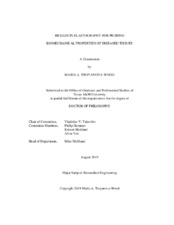| dc.description.abstract | The overall physiological function of a tissue or organ is closely related to its mechanical properties. These properties may change during many normal physiological processes or as part of healthy adaptations to altered conditions. Outside of such routine changes, however, the healthy tissue or cell may undergo an abnormal change in mechanical properties as a result of disease or disorder. Quantifying the changes in mechanical properties can be used to deepen understanding of disease initiation and progression, or as a tool to aid diagnosis and treatment research. Various non-destructive, non- or minimally invasive elasticity-specific imaging modalities exist that are suitable for characterization of biological material. However, they generally are suitable for evaluations on either tissue or cell level, but not both. Spatial scale matters for biomechanical characterization, as cell-level biomechanical properties do not always correspond to the mechanical properties of the corresponding tissue. In order to fully understand the underlying mechanisms of various normal and pathophysiological processes, measurements on both tissue-level and cellular level are essential. An elastography method that does not have such limitation is Brillouin elastography, or Brillouin spectroscopy, a no-contact mechanically-specific technique. This dissertation is focused on developing and implementing a multi-modality experimental system that is capable of simultaneous Brillouin elastography, Raman spectroscopy and optional fluorescence widefield or brightfield imaging. The Brillouin spectroscopy component utilizes a tunable 532 nm excitation source, molecular iodine absorption filter for elastically scattered light suppression, and a VIPA-based spectrometer.
A novel multi-excitation Brillouin elastography approach is developed to improve SNR and correct for the distortions caused by the excessive iodine absorption, which allows to work with challenging highly-scattering samples. Lastly, the dissertation work includes tissue-level evaluations of three different pathologies: obesity, melanoma and muscular dystrophy. The selected studies showcase the application of Brillouin spectroscopy for evaluating mechanical changes in diseased tissues. | en |


